Inside The New York Botanical Garden
Exhibitions
Posted in Exhibitions, Kiku on October 22 2009, by Plant Talk
Both Battle Cold, Damp Weather in New York to Perform at Peak
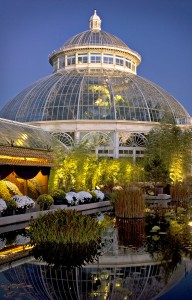 The grounds crew in Yankee Stadium has not been the only team compensating for Mother Nature’s freakishness this month.
The grounds crew in Yankee Stadium has not been the only team compensating for Mother Nature’s freakishness this month.
Across the Bronx at The New York Botanical Garden, the horticulture team is also doing some fancy footwork due to the weather—manipulating the Japanese-style chrysanthemum “sculptures” in the spectacular exhibition Kiku in the Japanese Autumn Garden.
For this year’s eagerly awaited flower show, cold temperatures and overcast skies have NYBG staff gardeners giving the mums needed extra light and warmth by bringing them back into the greenhouse.
Specific amounts of light and heat are needed to bring the chrysanthemums into flower. Those needs in this, the final year that the Garden is presenting its most elaborate show, are in direct contrast to what was needed in the first two years of the exhibition. Then, warm, late-summer temperatures persisted through October causing staff gardeners to scramble in order to shade and cool the plants to be presentable for the show.
Always anticipating change and preserving flexibility, the gardeners have grown a backup set of Kiku mums, keeping them outside in the chill all the time. This backup mum set can be moved into the show to replace the first set in case warm weather and bright sun send their flowers past peak before the show ends.
Visitors can appreciate this marvelous manipulation of Mother Nature and see the fruits of the horticulture team’s labor now through November 15. Kiku in the Japanese Autumn Garden showcases the spectacular autumn landscapes of Japanese gardens, with scarlet maples and golden bamboos against the backdrop of emerald conifers and, when the sun cooperates, clear blue skies. More chrysanthemums than ever are on display in traditional and contemporary display styles, with bonsai providing another fabulous element to the exhibition. On weekends, participate in guided tours, autumn gardening demonstrations, and taiko drumming performances.
Get Your Tickets
Posted in Exhibitions, Kiku on October 21 2009, by Plant Talk
Special Display by Yama Ki Society on through November 1
 |
Michael Pollock is Vice-President of Yama Ki Bonsai Society, whose members will display their bonsai in the Enid A. Haupt Conservatory during Kiku in the Japanese Autumn Garden. |
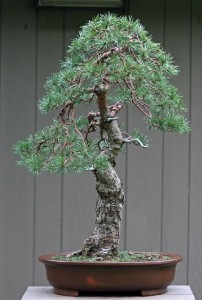 Bonsai’s beginning is shrouded in the mists of time. With origins in either China or India, bonsai (or penjing in Chinese) found fertile ground when visiting Buddhist monks brought potted trees to Japan. When Japan opened up to the West, interest in bonsai, which means “tray planting,” reignited throughout Asia and began to spread to other parts of the world. As the art form continues to reach new areas, new plants are used to create local bonsai. Whatever the climate, there are plants that can make beautiful bonsai.
Bonsai’s beginning is shrouded in the mists of time. With origins in either China or India, bonsai (or penjing in Chinese) found fertile ground when visiting Buddhist monks brought potted trees to Japan. When Japan opened up to the West, interest in bonsai, which means “tray planting,” reignited throughout Asia and began to spread to other parts of the world. As the art form continues to reach new areas, new plants are used to create local bonsai. Whatever the climate, there are plants that can make beautiful bonsai.
I first studied bonsai in 1982 with Yuji Yoshimura at The New York Botanical Garden. I was immediately captivated by a mixture of feelings these trees elicited from me: tranquility, calmness, excitement. Unfortunately, a busy career prevented me from seriously practicing bonsai then and I gave up. Twelve years ago, I realized that if I could successfully raise children, I could probably grow bonsai, too. It has been a wonderful journey of discovery and creation ever since. Now I grow between 40 and 50 bonsai. In 2004 I won a prestigious “new talent” competition and was awarded a trip to Japan, where I visited many of the most famous bonsai nurseries, growing fields, and public and private collections.
There are many ways to create a bonsai: starting with seeds or cuttings, buying a plant from a nursery (Shanti Bithi Bonsai Nursery in Stamford, Conn, has been an important resource) or collecting a tree from the wild. Of course, for beginners it takes longer to establish an impressive bonsai, but someone with experience can create a “showable” tree within three to five years. Older bonsai plants bring their own stories with them as they are trained, whether it be the twisted and scarred trunks with old, flaky bark or the bonsai practitioners who have cared for the tree over generations, as is witnessed in Japan and China.
Read More
Posted in Exhibitions, Kiku on October 16 2009, by Plant Talk
Last Year to Experience this Fall Extravaganza
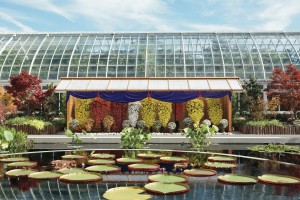 Chrysanthemums trained in a variety of growing styles, maples aglow in autumn colors, and the soft, rustling effects of grasses and bamboos showcase the splendor and diversity of Japanese gardens in Kiku in the Japanese Autumn Garden, from October 17 through November 15 in the Enid A. Haupt Conservatory Courtyards.
Chrysanthemums trained in a variety of growing styles, maples aglow in autumn colors, and the soft, rustling effects of grasses and bamboos showcase the splendor and diversity of Japanese gardens in Kiku in the Japanese Autumn Garden, from October 17 through November 15 in the Enid A. Haupt Conservatory Courtyards.
This is the Botanical Garden’s third and final showing of kiku—chrysanthemums meticulously trained by Garden horticulturists for up to 11 months and resulting in elaborate displays. Cultivated from tiny cuttings, the plants are pinched back, tied to frames, and nurtured to grow into particular shapes. The four traditional styles (single stem, thousand bloom, cascade, and driving rain) presented under special decorative structures known as uwaya are accompanied by large installations of contemporary styles such as cones, columns, and spheres.
Bonsai, a crowd favorite, is shown throughout the exhibition in the Courtyard and a special display of bonsai will be presented in the Conservatory through November 1. Other happenings during Kiku include educational children’s activities in Japanese Autumn Adventures, a Japanese Plant Tour throughout the grounds, weekend performances by taiko drummers, an art exhibition, Ex Libris: Treasures from the LuEsther T. Mertz Library, and a photography show, The Presence of Trees.
Click here to watch video highlights of Kiku.
Get Your Tickets
Posted in Exhibitions, Kiku on October 8 2009, by Plant Talk
 |
Todd Forrest is Vice President for Horticulture and Living Collections.
|
 |
Jessica Blohm is Interpretive Specialist for Public Education. |
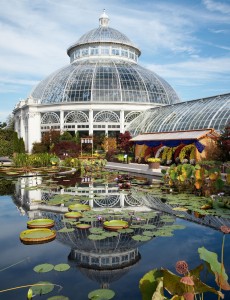 With comparable latitude and climate as eastern North America, Japanese gardens and hillsides in fall become a dappled canvas of scarlet, gold, and orange, just as they do here. Millions of Japanese travel in cars, buses, and trains to reach a favorite viewing spot—often a rugged mountain landscape or a garden belonging to a temple or shrine—to view the changing leaves and flowers.
With comparable latitude and climate as eastern North America, Japanese gardens and hillsides in fall become a dappled canvas of scarlet, gold, and orange, just as they do here. Millions of Japanese travel in cars, buses, and trains to reach a favorite viewing spot—often a rugged mountain landscape or a garden belonging to a temple or shrine—to view the changing leaves and flowers.
Maples (kaede) are the main source of stunning autumn colors along with emerald conifers, bamboo, chrysanthemums (kiku), and Japanese perennials, grasses, and ferns. Beginning October 17, the Enid A. Haupt Conservatory Courtyards will again come alive with two gardens that celebrate ancient Japanese horticultural traditions and the brilliant hues of chrysanthemums and Japanese garden plants in Kiku in the Japanese Autumn Garden.
For the past two years, chrysanthemums trained using traditional Japanese methods have been the centerpiece of the Garden’s autumn offerings. This year will be the final showing of this special presentation of kiku, and it will be combined with other elements that make viewing Japanese gardens in autumn memorable.
Garden design has been an important Japanese art for centuries. Many traditional Japanese gardens were closed to the public. Built by the elite for their own use or as temple gardens, they served as places for peaceful worship and quiet contemplation. Gardens in Japan are not simply a collection of plants; they are an interpretation of the natural landscape. Each element has a specific meaning and inspiration.
Read More
Posted in Exhibitions, The Edible Garden on September 11 2009, by Plant Talk
Last Chance to Experience The Edible Garden
 The summer-long celebration The Edible Garden comes to a close this weekend with two days jam-packed with exciting events. Emeril Lagasse takes center stage at the Conservatory Kitchen on Saturday and Lidia Bastianich is featured on Sunday, highlighting a lineup of cooking demonstrations by a number of renowned celebrity chefs. The summer-long celebration The Edible Garden comes to a close this weekend with two days jam-packed with exciting events. Emeril Lagasse takes center stage at the Conservatory Kitchen on Saturday and Lidia Bastianich is featured on Sunday, highlighting a lineup of cooking demonstrations by a number of renowned celebrity chefs.
Also featured on both days are cookbook author signings; food, wine, and beer tastings; home gardening demonstrations; science chats; edible gardening talks; tours of display gardens; and children’s activities. Get your tickets now to ensure premium seating for the main attractions. |
Posted in Exhibitions, People, The Edible Garden on September 10 2009, by Plant Talk
Bronx Green-Up Tours, Harvest Fair on Tap this Weekend
 |
Karen Washington is a community gardener and activist. As part of The Edible Garden final weekend, she will lead a tour of the Garden of Happiness.
|
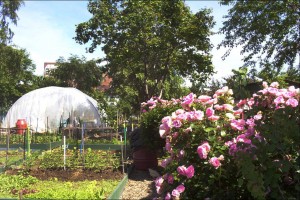 When I was 8 years old I used to watch the farm report before Saturday morning cartoons and wish and hope that one day I’d have my own farm.
When I was 8 years old I used to watch the farm report before Saturday morning cartoons and wish and hope that one day I’d have my own farm.
And now, in a way, I do. It may not be what some might think of as a traditional farm, but it’s the closest thing possible: a community garden.
I turned my passion for gardening into community gardening and activism—they go hand-in-hand—over 20 years ago. I want people to be aware that they can grow their own food wherever they are. I live in a low-income neighborhood, and I help educate people to go back to the land, because our grandparents and great-grandparents did not go to a supermarket or grocery store to buy their food; they grew it themselves.
The interest in community gardening has grown in recent years as people are starting to connect their health issues with not knowing where their food comes from. Child obesity—I mean diabetes at the age of 12 or 13!—wasn’t happening to our grandparents or great-grandparents. So now the younger generation is really sitting down and speaking to their elders and having that conversation. And with over 600 community gardens in New York City that you can join for free, the combination creates an atmosphere for people to really want to grow their own food.
At my garden—I belong to the Garden of Happiness on Prospect Avenue between East 181st and 182nd Streets in the Bronx—we have 30 families. Each is assigned a specific plot—the plot can be 5 by 6 feet, 10 by 15 feet—to grow what they want. The Botanical Garden’s Bronx Green-Up program and the NYC Department of Parks & Recreation’s GreenThumb program supply us with lumber for raised beds, tools, plants, seeds, soil, and compost. We bring our sweat and our hard labor.
Read More
Posted in Exhibitions, The Edible Garden on September 8 2009, by Plant Talk
 |
Daisy Martinez is host of Viva Daisy! on the Food Network and author of Daisy Cooks! Latin Flavors that Will Rock Your World. She will present a cooking demonstration on Sunday, The Edible Garden’s final weekend.
|
When I was a little girl, I used to marvel at how my mother and her mother could grow anything and everything in their garden. Mama Clotilde, my maternal grandmother, would grow medicinal herbs in her garden along with a variety of beans, a banana tree, a prolific breadfruit tree, mangoes, achiote, grapefruit, yucca, and avocados. She would send us out to the garden before dinnertime to collect whatever she needed to create delicious meals. When my family moved to Staten Island in 1964, it was no small wonder that Mami’s first order of business was to set up her vegetable garden in the backyard…and what a garden it was!
Mami, like her mother before her, was born with a green thumb. I mean, the woman just has to wave her hand over anything green and she charms it like a snake charmer! In no time flat (and after a trip to a nearby stable to pick up some manure), Mami had rows of lettuce, tomatoes, beans (against the backyard fence), eggplant, sweet peppers, ajicitos dulces, cilantro, culantro, basil, rue, scallions, zucchini, sugar beats, radishes, and even watermelon! We had a peach tree in the yard that yielded juicy, delicious yellow peaches, and a plum tree that yielded sweet little black plums that we would eat by the dozen!
Mami would tend her garden with everything from coffee grinds to eggshells and involved me in the weeding, harvesting, and pest control (pie plates full of beer for slug control, anyone?). And although I assumed that I would pick up a lot of her skills through osmosis, when I got married and felt the need to start my own garden, I found that I did not inherit the green thumb that my mother, and her mother before her, had waved in my face with impunity! Not to be outdone, I headed to my local botanical garden and library, and although I cannot compete with my grandmother’s or Mami’s garden, I find that I can fend for myself these days.
I grow my own herbs, of course: I keep thyme, lemon thyme, cinnamon basil and regular basil, cilantro, chiles, sage, and parsley. This year I grew jalapeno, Madagascar hot chiles, plum tomatoes, and sweet fennel. I have a couple of blueberry bushes that my children hit up around breakfast time everyday during the summer, and my raspberry bushes aren’t too shabby either. It is a humble, if inadequate homage to Mami and Mama Clotilde’s gardens of paradise, but an homage nonetheless. I can only hope that my simple little garden serves to inspire my daughter (and sons!) to one day have one of their own.
Posted in Exhibitions, Science, The Edible Garden on September 7 2009, by Plant Talk
 |
Valerie Imbruce, Ph.D., Professor and Director of Environmental Studies at Bennington College in Vermont who was a doctoral student at the Botanical Garden, researches the production and distribution of ethnic fruits and vegetables for New York City markets. She will be holding an informal conversation about ethnic fruits and vegetables in Chinatown and urban food systems during Café Scientifique on September 12 as part of The Edible Garden. |
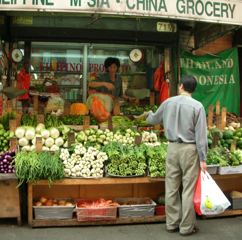 Cities, home to half of the world’s growing population, are poised to redefine how we produce and supply our food. Cities are where people are demanding more farmers markets and community supported agriculture groups and where there is a local agriculture craze. Food is a social movement with a particularly urban flavor.
Cities, home to half of the world’s growing population, are poised to redefine how we produce and supply our food. Cities are where people are demanding more farmers markets and community supported agriculture groups and where there is a local agriculture craze. Food is a social movement with a particularly urban flavor.
Living in southern Vermont for the past year after being in New York for nearly a decade, I learned that in New York City it is easier to purchase a diet of regionally produced foods than in the food-producing regions themselves because of the structure of our food supply chains.
Since World War II the number of farms in the United States had been declining, but between 2002 and 2007, the last year for which data were available, there was a 4 percent increase. According to the U.S. Census of Agriculture, these new farms are half the size of the average U.S. farm, have younger operators, and have sales of which one product accounts for no more than 50% of the farm income. These are the types of farms, small and diversified run by a new generation of farmers, which farmers markets, community supported agriculture, and chef-farm partnerships have been the primary supporters of.
But direct marketing arrangements are not enough to support a sustained increase in farm numbers: The volume of food sold directly from farm to consumer is a drop in the bucket compared with the volume of food that is sold through wholesale distribution. Why should New York, the second largest apple producing state in the nation, export its apples and then turn around and import apples from Chile and New Zealand for New Yorkers to eat? Why should the United States export more than 4,000 tons of yogurt and then import just over the same volume? It’s because fundamental aspects of the “mainstream” food system make it difficult for regional farmers to access their regional urban markets. We need to get commodity agriculture and supermarkets on board to change this, and we need city government to create policies to ensure access to urban markets by regional farmers.
Read More
Posted in Exhibitions, Programs and Events, The Edible Garden on September 4 2009, by Plant Talk
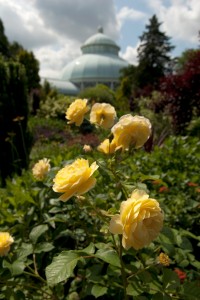
With the beautiful weather and a three-day respite from work (for most), this is a great time to get away to the Botanical Garden—and without going far. Enjoy the waning days of summer viewing the lush Perennial Garden, Seasonal Walk, and Rose Garden. Catch The Edible Garden in its penultimate weekend with tours, cooking demos, children’s activities, and more. Take a bird walk or attend the Greenmarket on Saturday, enjoy poetry readings on Sunday, relax on a Tram Tour of the Garden’s 250-acres on Monday (or any day). You can do all these wonderful things with an All-Garden Pass.
|
Posted in Exhibitions, Programs and Events, The Edible Garden on September 4 2009, by Plant Talk
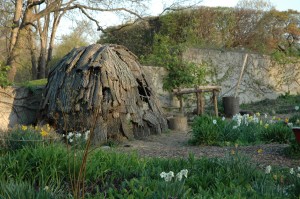 A few weeks ago, during one of many rainstorms in the Ruth Rea Howell Family Garden this summer, I took refuge with a few students from our Children’s Gardening Program in the wigwam tucked in the side corner of the garden’s Meadow. While the kids played giddy musical chairs on the stumps inside, I sat quietly with my back against the bark wall. It’s a cozy space. Although the kids were acting loud and giggly, the small wigwam felt peaceful. The rain fell near-noiselessly on the dome of birch saplings. Through the wigwam’s single window, daylilies and tall zebra grass shone orange and green against the gray.
A few weeks ago, during one of many rainstorms in the Ruth Rea Howell Family Garden this summer, I took refuge with a few students from our Children’s Gardening Program in the wigwam tucked in the side corner of the garden’s Meadow. While the kids played giddy musical chairs on the stumps inside, I sat quietly with my back against the bark wall. It’s a cozy space. Although the kids were acting loud and giggly, the small wigwam felt peaceful. The rain fell near-noiselessly on the dome of birch saplings. Through the wigwam’s single window, daylilies and tall zebra grass shone orange and green against the gray.
Part of the Three Sisters display garden, the wigwam was built in 2006 to re-create the lifestyle of the Lenni-Lenape, the first New York natives. When teaching, I often ask my students to imagine what it would be like to live as the Lenape did 400 years ago. I ask the children to think about everything they do inside their homes—cook, read, watch TV, play with toys, take refuge in air conditioning when the summer hits—and think of what the Lenape would be doing instead. With seven-year-olds, of course, a reflective discussion like this leads to hilarity pretty quickly.
But after some groans and giggles about sharing a bedroom with your whole family, comparing lifestyles leads to an epiphany as well. The wigwam only seems small in comparison to today’s houses when you think about it as an equal living environment. But it isn’t. In those early, pre-hustle-and-bustle New York years, an entire world around the home provided the space for cooking, playing, harvesting. (Who needs air conditioning with the Bronx River running so close by?) What I like about the wigwam is its clear definition of necessity. It’s a space of shelter and sleep. Imagination provides the rest.
Read More
 The grounds crew in Yankee Stadium has not been the only team compensating for Mother Nature’s freakishness this month.
The grounds crew in Yankee Stadium has not been the only team compensating for Mother Nature’s freakishness this month.














